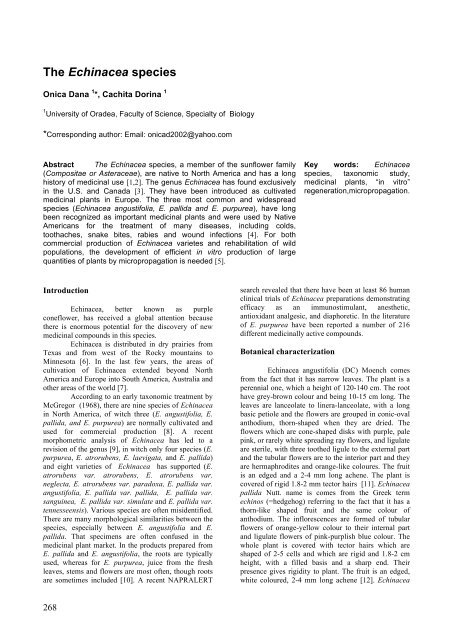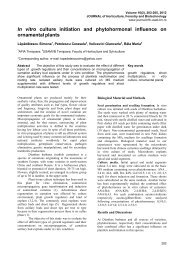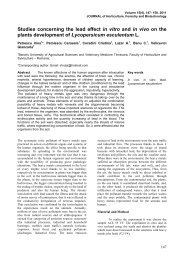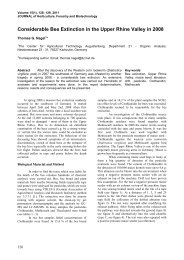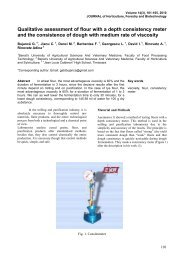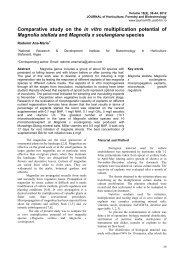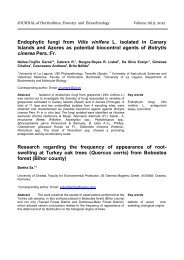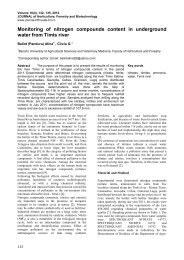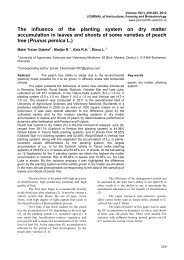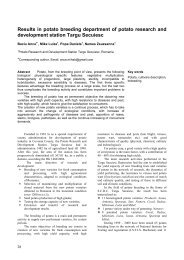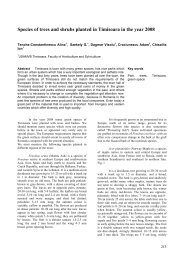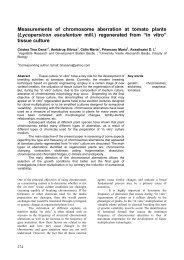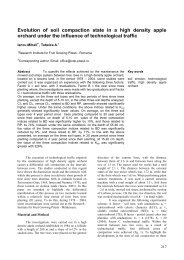The Echinacea species
The Echinacea species
The Echinacea species
Create successful ePaper yourself
Turn your PDF publications into a flip-book with our unique Google optimized e-Paper software.
<strong>The</strong> <strong>Echinacea</strong> <strong>species</strong><br />
Onica Dana 1 *, Cachita Dorina 1<br />
1 University of Oradea, Faculty of Science, Specialty of Biology<br />
*Corresponding author: Email: onicad2002@yahoo.com<br />
Abstract <strong>The</strong> <strong>Echinacea</strong> <strong>species</strong>, a member of the sunflower family<br />
(Compositae or Asteraceae), are native to North America and has a long<br />
history of medicinal use [1,2]. <strong>The</strong> genus <strong>Echinacea</strong> has found exclusively<br />
in the U.S. and Canada [3]. <strong>The</strong>y have been introduced as cultivated<br />
medicinal plants in Europe. <strong>The</strong> three most common and widespread<br />
<strong>species</strong> (<strong>Echinacea</strong> angustifolia, E. pallida and E. purpurea), have long<br />
been recognized as important medicinal plants and were used by Native<br />
Americans for the treatment of many diseases, including colds,<br />
toothaches, snake bites, rabies and wound infections [4]. For both<br />
commercial production of <strong>Echinacea</strong> varietes and rehabilitation of wild<br />
populations, the development of efficient in vitro production of large<br />
quantities of plants by micropropagation is needed [5].<br />
Key words: <strong>Echinacea</strong><br />
<strong>species</strong>, taxonomic study,<br />
medicinal plants, “in vitro”<br />
regeneration,micropropagation.<br />
Introduction<br />
<strong>Echinacea</strong>, better known as purple<br />
coneflower, has received a global attention because<br />
there is enormous potential for the discovery of new<br />
medicinal compounds in this <strong>species</strong>.<br />
<strong>Echinacea</strong> is distributed in dry prairies from<br />
Texas and from west of the Rocky mountains to<br />
Minnesota [6]. In the last few years, the areas of<br />
cultivation of <strong>Echinacea</strong> extended beyond North<br />
America and Europe into South America, Australia and<br />
other areas of the world [7].<br />
According to an early taxonomic treatment by<br />
McGregor (1968), there are nine <strong>species</strong> of <strong>Echinacea</strong><br />
in North America, of witch three (E. angustifolia, E.<br />
pallida, and E. purpurea) are normally cultivated and<br />
used for commercial production [8]. A recent<br />
morphometric analysis of <strong>Echinacea</strong> has led to a<br />
revision of the genus [9], in witch only four <strong>species</strong> (E.<br />
purpurea, E. atrorubens, E. laevigata, and E. pallida)<br />
and eight varieties of <strong>Echinacea</strong> has supported (E.<br />
atrorubens var. atrorubens, E. atrorubens var.<br />
neglecta, E. atrorubens var. paradoxa, E. pallida var.<br />
angustifolia, E. pallida var. pallida, E. pallida var.<br />
sanguinea, E. pallida var. simulate and E. pallida var.<br />
tennesseensis). Various <strong>species</strong> are often misidentified.<br />
<strong>The</strong>re are many morphological similarities between the<br />
<strong>species</strong>, especially between E. angustifolia and E.<br />
pallida. That specimens are often confused in the<br />
medicinal plant market. In the products prepared from<br />
E. pallida and E. angustifolia, the roots are typically<br />
used, whereas for E. purpurea, juice from the fresh<br />
leaves, stems and flowers are most often, though roots<br />
are sometimes included [10]. A recent NAPRALERT<br />
search revealed that there have been at least 86 human<br />
clinical trials of <strong>Echinacea</strong> preparations demonstrating<br />
efficacy as an immunostimulant, anesthetic,<br />
antioxidant analgesic, and diaphoretic. In the literature<br />
of E. purpurea have been reported a number of 216<br />
different medicinally active compounds.<br />
Botanical characterization<br />
<strong>Echinacea</strong> angustifolia (DC) Moench comes<br />
from the fact that it has narrow leaves. <strong>The</strong> plant is a<br />
perennial one, which a height of 120-140 cm. <strong>The</strong> root<br />
have grey-brown colour and being 10-15 cm long. <strong>The</strong><br />
leaves are lanceolate to linera-lanceolate, with a long<br />
basic petiole and the flowers are grouped in conic-oval<br />
anthodium, thorn-shaped when they are dried. <strong>The</strong><br />
flowers which are cone-shaped disks with purple, pale<br />
pink, or rarely white spreading ray flowers, and ligulate<br />
are sterile, with three toothed ligule to the external part<br />
and the tubular flowers are to the interior part and they<br />
are hermaphrodites and orange-like coloures. <strong>The</strong> fruit<br />
is an edged and a 2-4 mm long achene. <strong>The</strong> plant is<br />
covered of rigid 1.8-2 mm tector hairs [11]. <strong>Echinacea</strong><br />
pallida Nutt. name is comes from the Greek term<br />
echinos (=hedgehog) referring to the fact that it has a<br />
thorn-like shaped fruit and the same colour of<br />
anthodium. <strong>The</strong> inflorescences are formed of tubular<br />
flowers of orange-yellow colour to their internal part<br />
and ligulate flowers of pink-purplish blue colour. <strong>The</strong><br />
whole plant is covered with tector hairs which are<br />
shaped of 2-5 cells and which are rigid and 1.8-2 cm<br />
height, with a filled basis and a sharp end. <strong>The</strong>ir<br />
presence gives rigidity to plant. <strong>The</strong> fruit is an edged,<br />
white coloured, 2-4 mm long achene [12]. <strong>Echinacea</strong><br />
268
purpurea (L.) Moench is bush-like shaped, with 80-<br />
100 cm height. Its roots have many ramifications<br />
which are oblique positioned and they are light-brown<br />
coloured. <strong>The</strong> stem has red coloured basis and ends and<br />
oval-lanceolate, 5-nervation leaves, the basic ones<br />
being long petiolate and the top ones are sessile and<br />
short petiolate.<br />
<strong>The</strong> flowers are grouped in inflorescences<br />
anthodium. <strong>The</strong>se ones are large, having the involucre<br />
shaped of three types of folioles. <strong>The</strong> ligules are<br />
intensely red coloured and the frit is represented by an<br />
edged achene, white coloured, with a rudimentary<br />
pappus, coronule shaped and having a 3-5 mm size.<br />
<strong>The</strong> plant has short, rigid hairs.<br />
Fig.3 Structure of caftaric acid C 13 H 12 O 9<br />
Fig. 4 Structure of chlorogenic acid C 16 H 18 O 9<br />
Secundary metabolites of <strong>Echinacea</strong><br />
Higher plants produce a great variety of<br />
secondary metabolites, which have been used as<br />
pharmaceuticals, nutraceuticals and food additives.<br />
Recent advance in the techniques and applications of<br />
plant cell and organ cultures have made it possible to<br />
produce these valuable secondary metabolites in large<br />
scale. Moreover, plant cell culture system provide<br />
various ways to boost yields of desired metabolites,<br />
conveniently and cost effectively [13]. <strong>Echinacea</strong><br />
purpurea is a medicinal plant, which has shown<br />
antioxidative, antibacterial, antiviral and antifungal<br />
properties, and is used in the tratment for common<br />
cold, as well as respiratory and urinary diseases [14].<br />
<strong>The</strong> main bioactive constituents are caffeic acid<br />
derivatives (Fig. 1), alkylamides, polyacetylenes and<br />
polysaccharides [15]. Whith regard to caffeic acid<br />
derivatives, several compounds have been identified<br />
from hydrophilic fraction of E. purpurea, which<br />
revealed that caftaric acid (Fig. 3), chichoric acid (Fig.<br />
2) and chlorogenic acid (Fig. 4) are the important ones.<br />
Fig. 1 Structure of caffeic acid C 9 H 8 O 4<br />
Fig. 2 Structure of cichoric acid C 22 H 18 O 12<br />
<strong>Echinacea</strong> biotechnology<br />
For rehabilitation of wild population of<br />
<strong>Echinacea</strong> varietes and for comercial production of<br />
<strong>Echinacea</strong> <strong>species</strong>, the development of efficient in<br />
vitro production of large quatities of plants by<br />
micropropagation is nedeed. Regeneration of mature<br />
shoots from callus and suspension cultures is a critical<br />
requirement for the application of in vitro selection [5].<br />
In vitro tissue culture of <strong>Echinacea</strong> can play a<br />
vital role in the development of novel germplasm,<br />
rapid multiplication, and genetic modification for an<br />
enhanced phytochemical production.<br />
Recent establishment of liquid culture<br />
techniques, large-scale bioreactors, and<br />
Agrobacterium-mediated transformation are changing<br />
the production parameters of the <strong>Echinacea</strong> <strong>species</strong><br />
[16]. A new method provides an efficient system of<br />
adventitious shoot regeneration from leaf explants of<br />
E. purpurea that will useful for micropropagation of<br />
elite ornamental or chemotype selection of this<br />
medicinal <strong>species</strong>. In addition, this regeneration<br />
system, combined with Agrobacterium transformation,<br />
provides a method for routine genetic transformation of<br />
this important medicinal <strong>species</strong>.<br />
Micropropagation of three <strong>Echinacea</strong> <strong>species</strong>,<br />
E. purpurea Moench., E. angustifolia DC., and E.<br />
pallida Nutt., was investigated as a potential means of<br />
germplast preservation of <strong>species</strong> faced with<br />
overcollection in the wild and rapid clonal propagation<br />
of elite individuals with unique medicinal or<br />
ornamental properties. Very high contamination rates<br />
occured with shoot-tip explants but not with nodal<br />
segments [17].<br />
269
In vitro regeneration and production offers<br />
many advantages for the growth of medicinal plants in<br />
general and more specifically <strong>Echinacea</strong> as it offers the<br />
capacity to optimize all growth conditions [18].<br />
<strong>The</strong>re have been several previous reports of in<br />
vitro regeneration in the literature from E. purpurea<br />
and E. tennesseensis - Coker and Camper, 1999;<br />
Choffe et al., 2000; Koroch et al., 2002; Mechanda et<br />
al., 2003; Zobayed and Saxena, 2003; Sauve et al.,<br />
2004; Jones et al., 2006 - and two reports of<br />
agrobacterium-mediated transformation in this <strong>species</strong><br />
- Koroch et al., 2002b; Wang and To, 2004 - however,<br />
a wide range of different responses have been observed<br />
in explants cultured on identical culture medium and<br />
Conclusions<br />
1. Important morphological and anatomical<br />
characteristics of <strong>Echinacea</strong> plants are<br />
described for the purpose of<br />
pharmacognostical identification of the drugs.<br />
2. Direct multiple shoot production from leaf<br />
explants is critical to produce a large number<br />
of uniform plants from the elite lines of<br />
mature E. purpurea plants.<br />
3. <strong>The</strong> high efficiency regeneration method from<br />
mature plants of E. purpurea is useful for the<br />
evaluation of native populations for desired<br />
chemicals. This will help in developing<br />
regeneration protocols for the near-extinct<br />
varietes and other <strong>species</strong> of <strong>Echinacea</strong>.<br />
4. Other <strong>Echinacea</strong> <strong>species</strong> have been<br />
propagated in vitro from root, hypocotyls,<br />
cotyledon, stem and from leaf explants. That<br />
study was undertaken to develop a<br />
regeneration protocol for the mass<br />
propagation and preservation of the rare<br />
<strong>Echinacea</strong> <strong>species</strong>.<br />
5. <strong>The</strong> plant production can be scheduled<br />
throughout the year since the entire process is<br />
completed in a controlled environment<br />
ensuring a year round supply of high quality<br />
product as well as increasing the economic<br />
viability for the producer.<br />
References<br />
1. Shemluck, M., 1982 – Medicinal and other<br />
uses of the Compositae by Indians in<br />
the United States and Canada – Journal<br />
of Ethnopharmacology 5: 303-358;<br />
2. Bauer, R. 1998 - Standardization of<br />
<strong>Echinacea</strong> purpurea expressed juice<br />
with reference to cichoric acid and<br />
alkamides. J. Herbs Spices Med. Plants<br />
loc.cit.<br />
3. McGregor RL, 1968 - <strong>The</strong> taxonomy of the<br />
genus <strong>Echinacea</strong> (Compositae). Univ.<br />
of Kansas Sci. Bul.;48:113–142<br />
there has been no systematic study of the chemical<br />
diversity among regenerated plants [18].<br />
Micropropagation offers an approach that is<br />
capable of producing large number of genetically<br />
similar, disease free plants in a short period of time and<br />
limited space [19]. Although there are several reports<br />
of in vitro regeneration of E. purpurea, they have all<br />
been conducted using solid media, and could be further<br />
improved by developing a liquid-based system<br />
[20,21,22,5,23].<br />
4. Bauer, R. and H. Wagner, 1991 - <strong>Echinacea</strong><br />
<strong>species</strong> as potential immunostimulatory<br />
drugs. In: H. Wagner and N.R.<br />
Farnsworth (eds.), Economic and<br />
medicinal plant research. Academic<br />
Press, New York, Vol. 5/8. p. 253–321.<br />
5. Mechanda, S. M., B. R. Baum, D. A. Johnson<br />
and J. T. Arnason, 2003 - Direct shoot<br />
regeneration from leaf segments of<br />
mature plants of <strong>Echinacea</strong> purpurea<br />
(L.) Moench. In Vitro Cell. Dev. Biol.<br />
Plant 39:505–509.<br />
6. Bauer, R. and S. Foster. 1991 - Analysis of<br />
alkamides and caffeic acid derivatives<br />
from <strong>Echinacea</strong> simulata and E.<br />
paradoxa roots. Planta Med. 57:447–<br />
449.<br />
7. Yu, H. C. and M. Kaarlas 2004 - Popularity,<br />
diversity, and quality of <strong>Echinacea</strong>. In<br />
Miller, S., editor. (ed). <strong>Echinacea</strong>. <strong>The</strong><br />
genus <strong>Echinacea</strong>. CRC Press. Boca<br />
Raton, FL. pp. 29–52.<br />
8. Cox, P. B. and L. E. Urbatsch, 1990 - A<br />
phylogenetic analysis of the coneflower<br />
genera. Syst. Bot. 15:394–402<br />
9. Binns SE, Baum BR, Arnason JT, 2002a - A<br />
taxonomic revision of <strong>Echinacea</strong><br />
(Asteraceae: Heliantheae). Syst<br />
Bot.;27:610–632<br />
10. Schulz V, Hansel R, Tyler VE, 2000 -<br />
Rational Phytotherapy. Berlin<br />
(Germany): Springer-Verlag Berlin<br />
Heidelberg,.<br />
11. Muntean L., Salontai A. , Tamas M. , Botez<br />
C., Vaida F., 1989 - Research on the<br />
biology of <strong>Echinacea</strong> angustifolia (Dc.)<br />
Moench and <strong>Echinacea</strong> purpurea (L.)<br />
Moench, Zeitraum1976 – 2001,<br />
ScientifiCcommons.<br />
12. Muntean L., Salontai A., Botez C., Tamas M.,<br />
Cernea S., Morar G., Vaida F., 1991 -<br />
Research on the biology of <strong>Echinacea</strong><br />
pallida Nutt. and <strong>Echinacea</strong> purpurea<br />
(L.) Moench (II), Zeitraum1976 – 2001,<br />
ScientifiCcommons<br />
270
13. Rao, R.N., T. Ravisankar & K. Satyanarayana<br />
R., 2002 - Ethnobotany-an essential<br />
tool for biodiversity conservation.<br />
National Workshop on Peoples<br />
Participatory Approaches in<br />
Conservation and Management of<br />
Forest Resources held at Kakinada,<br />
Andhra Pradesh, India, M. S.<br />
Swaminathan Research Foundation,<br />
Kakinada and FAO<br />
14. Barrett B. - Medicinal properties of<br />
<strong>Echinacea</strong>: a critical review,<br />
Phytomedicine. 2003 Jan;10(1):66-86<br />
15. Bauer R, Hoheisel O, Stuhlfauth I, Wolf H.,<br />
1999 - Extract of the <strong>Echinacea</strong><br />
purpurea herb: an allopathic<br />
phytoimmunostimulant, Wien Med<br />
Wochenschr.;149(8-10):185-9<br />
16. Abbasi, B. H., C. L. Tian, S. J. Murch, P. K.<br />
Saxena, and C. Z. Liu, 2007 - Light<br />
enhanced caffeic acid derivatives<br />
biosynthesis in hairy root cultures of<br />
<strong>Echinacea</strong> purpurea. Plant Cell Rep (in<br />
press). DOI 10.1007.<br />
17. Harbage, J. F., 2001 - Micropropagation of<br />
<strong>Echinacea</strong> angustifolia, E. pallida, and<br />
E. purpurea from stem and seed<br />
explants. HortScience 36:360–364.<br />
18. Murch, S. J., S.E. Peiris, W.L. Shi, S.M.A.<br />
Zobayed, P.K. Saxena, 2006 – Genetic<br />
diversity in seed populations of<br />
<strong>Echinacea</strong> purpurea controls the<br />
capacity for regeneration, route of<br />
morphogenesis and phytochemical<br />
composition. Plant Cell Report. 25:522-<br />
532.<br />
19. Jones, M.P.A., Z Yi, SJ Murch, PK Saxena,<br />
2007 - Thidiazuron-induced<br />
regeneration of <strong>Echinacea</strong> purpurea L.,<br />
Plant Cell Reports.<br />
20. Choffe, L. L., S. J. Murch, and P. K. Saxena.<br />
2000 - Regeneration of <strong>Echinacea</strong><br />
purpurea: induction of root<br />
organogenesis from hypocotyls and<br />
cotyledon explants. Plant Cell Tiss.<br />
Organ Cult. 62:227–234<br />
21. Koroch, A., H.R. Juliani, J. Kapteyn, and J.E.<br />
Simon, 2001 - In vitro regeneration of<br />
<strong>Echinacea</strong> purpurea from leaf explants.<br />
Plant Cell Tissue Organ Culture.<br />
22. Lakshmanan, P., M. Danesh, and A. Taji.<br />
2002 - Production of four commercially<br />
cultivated <strong>Echinacea</strong> <strong>species</strong> by<br />
different methods of in vitro<br />
regeneration. J. Hort. Sci. Biotechnol.<br />
77:158–163.<br />
23. Zobayed, S. M A. and P. K. Saxena. 2003 -<br />
In vitro-grown roots: a superior<br />
explant for prolific shoot regeneration<br />
of St. John's wort (Hypericum<br />
perforatum L. cv ‘New Stem) in a<br />
temporary immersion bioreactor. Plant<br />
Sci. 165:463–470<br />
271


